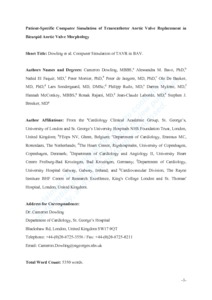Dowling, C;
Bavo, AM;
El Faquir, N;
Mortier, P;
de Jaegere, P;
De Backer, O;
Sondergaard, L;
Ruile, P;
Mylotte, D;
McConkey, H;
et al.
Dowling, C; Bavo, AM; El Faquir, N; Mortier, P; de Jaegere, P; De Backer, O; Sondergaard, L; Ruile, P; Mylotte, D; McConkey, H; Rajani, R; Laborde, J-C; Brecker, SJ
(2019)
Patient-Specific Computer Simulation of Transcatheter Aortic Valve Replacement in Bicuspid Aortic Valve Morphology.
Circ Cardiovasc Imaging, 12 (10).
e009178.
ISSN 1942-0080
https://doi.org/10.1161/CIRCIMAGING.119.009178
SGUL Authors: Brecker, Stephen
![[img]](https://openaccess.sgul.ac.uk/111301/1.hassmallThumbnailVersion/Patient-specific%20computer%20simulation%20of%20TAVR%20in%20BAV%20morphology.pdf)  Preview |
|
PDF
Accepted Version
Available under License ["licenses_description_publisher" not defined].
Download (2MB)
| Preview
|
Abstract
BACKGROUND: A patient-specific computer simulation of transcatheter aortic valve replacement (TAVR) in tricuspid aortic valve has been developed, which can predict paravalvular regurgitation and conduction disturbance. We wished to validate a patient-specific computer simulation of TAVR in bicuspid aortic valve and to determine whether patient-specific transcatheter heart valve (THV) sizing and positioning might improve clinical outcomes. METHODS: A retrospective study was performed on TAVR in bicuspid aortic valve patients that had both pre- and postprocedural computed tomography imaging. Preprocedural computed tomography imaging was used to create finite element models of the aortic root. Finite element analysis and computational fluid dynamics was performed. The simulation output was compared with postprocedural computed tomography imaging, cineangiography, echocardiography, and electrocardiograms. For each patient, multiple simulations were performed, to identify an optimal THV size and position for the patient's specific anatomic characteristics. RESULTS: A total of 37 patients were included in the study. The simulations accurately predicted the THV frame deformation (minimum-diameter intraclass correlation coefficient, 0.84; maximum-diameter intraclass correlation coefficient, 0.88; perimeter intraclass correlation coefficient, 0.91; area intraclass correlation coefficient, 0.91), more than mild paravalvular regurgitation (area under the receiver operating characteristic curve, 0.86) and major conduction abnormalities (new left bundle branch block or high-degree atrioventricular block; area under the receiver operating characteristic curve, 0.88). When compared with the implanted THV size and implant depth, optimal patient-specific THV sizing and positioning reduced simulation-predicted paravalvular regurgitation and markers of conduction disturbance. CONCLUSIONS: Patient-specific computer simulation of TAVR in bicuspid aortic valve may predict the development of important clinical outcomes, such as paravalvular regurgitation and conduction abnormalities. Patient-specific THV sizing and positioning may improve clinical outcomes of TAVR in bicuspid aortic valve.
| Item Type: |
Article
|
| Additional Information: |
This is a non-final version of an article published in final form in Dowling, C; Bavo, AM; El Faquir, N; Mortier, P; de Jaegere, P; De Backer, O; Sondergaard, L; Ruile, P; Mylotte, D; McConkey, H; et al. (2019) Patient-Specific Computer Simulation of Transcatheter Aortic Valve Replacement in Bicuspid Aortic Valve Morphology. Circ Cardiovasc Imaging, 12 (10). |
| Keywords: |
aortic valve, bicuspid aortic valve, finite element analysis, humans, transcatheter aortic valve replacement, aortic valve, bicuspid aortic valve, finite element analysis, humans, transcatheter aortic valve replacement, 1103 Clinical Sciences, Cardiovascular System & Hematology |
| SGUL Research Institute / Research Centre: |
Academic Structure > Molecular and Clinical Sciences Research Institute (MCS) |
| Journal or Publication Title: |
Circ Cardiovasc Imaging |
| ISSN: |
1942-0080 |
| Language: |
eng |
| Publisher License: |
Publisher's own licence |
| PubMed ID: |
31594409 |
| Dates: |
| Date |
Event |
| 2019-10 |
Published |
| 2019-10-09 |
Published Online |
| 2019-08-07 |
Accepted |
|
 |
Go to PubMed abstract |
| URI: |
https://openaccess.sgul.ac.uk/id/eprint/111301 |
| Publisher's version: |
https://doi.org/10.1161/CIRCIMAGING.119.009178 |
Statistics
Item downloaded times since 24 Oct 2019.
Actions (login required)
 |
Edit Item |



